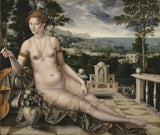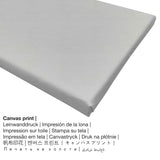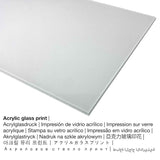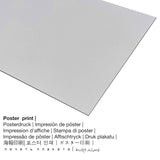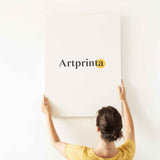Sélectionnez le matériau du produit de votre choix
Nous proposons une gamme de matériaux et de tailles différents pour chaque produit. Les tailles et matériaux suivants sont les options que nous vous proposons pour l'individualisation:
- Impression sur verre acrylique (avec revêtement en verre véritable): A glossy print on acrylic glass, often named a UV print on plexiglass, changes your favorite original into beautiful décor and makes a distinct alternative to dibond and canvas fine art replicas. The work of art will be custom-made with the help of state-of-the-art UV printing technology. The result of this are rich, sharp colors. The major benefit of an acrylic glass fine art copy is that contrasts and small artwork details become more identifiable with the help of the fine gradation of the print. Our acrylic glass protects your custom art replica against sunlight and external influences for up to 6 decades.
- Affiche imprimée (matériel de toile): A poster is a UV printed sheet of flat canvas with a slightly rough structure on the surface. Please note, that depending on the absolute size of the poster we add a white margin 2-6cm round about the artwork to facilitate the framing.
- Toile: A canvas print is a printed cotton canvas mounted on a wood frame. It has a plastic effect of three dimensionality. Hanging a canvas print: A canvas print has the advantage of being relatively low in weight, meaning that it is easy and straightforward to hang up your Canvas print without the help of extra wall-mounts. Canvas prints are suited for any type of wall.
- Impression dibond en aluminium: Aluminium Dibond prints are prints on metal with an outstanding depth. For the Print On Aluminum Dibond, we print your selected work of art onto the aluminium composite surface. The white & bright parts of the work of art shine with a silk gloss but without any glow. The colors of the print are bright and luminous, fine details are clear and crisp, and the print has a a matte appearance you can literally feel.
Avertissement: We try all that we can to depict our art products with as many details as possible and to exhibit them visually on the product detail pages. At the same time, the pigments of the printing material and the print result may vary to a certain extent from the representation on your device's monitor. Depending on the screen settings and the nature of the surface, colors can unfortunately not be printed as exactly as the digital version on this website. Considering that the fine art prints are processed and printed manually, there might as well be slight variations in the motif's exact position and the size.
Spécifications supplémentaires du site Web du musée (© Copyright - par Nationalmuseum Stockholm - Nationalmuseum Stockholm)
Kvinnan på bilden har tolkats som Flora, blommornas och blomningens gudinna eller Venus, kärlekens gudinna. Om vi antar att det är Venus som ligger utsträckt på divanen, så kan vi tolka pärlorna i gudinnas smycken; det porlandet vattnet ur fontänen och själva havet som breder ut sig i bakgrunden som symboler för kärleksgudinnan som enligt legenden föddes ur havet och därför förknippas med företeelser som har med vatten att göra. Trädgårdsnejlikorna som hon håller upp mot oss ansågs ha kärleksstimulerande egenskaper och i urnan vid hennes sida står en bukett med bland annat röda och vita rosor, vilka kan tolkas som symboler för kärleken. Klotet, som ligger på balustraden, ansågs under renässansen vara en fulländad form och kan ha målats dit för att syfta på Venus gudomligt fullkomliga skönhet. Påfågeln är symbolen för Juno, de antika gudarnas drottning och kvinnornas beskyddarinna. Den användes som tecken för kvinnans sensuella kraft, men kunde också tolkas moraliserande som varning för högmod, kvinnlig fåfänga och lyx. (Observera att det alltså var påfågelhanen, med sina vackra flerfärgade fjädrar, som associerades med "det kvinnliga") I trädgården, till höger om Venus, ser vi ett kärlekspar; en man som lyfter på hatten och går ned på knä framför en kvinna som sitter på trappan. På grund av förändringar av färgpigmenten verkar de idag nästan genomskinnliga. Innan målningen kom till Sverige, i samband med det så kallade Pragrovet 1648, tillhörde den kejsar Rudlof II. I hans inventarier hade den titeln Flora, vilket har fått flera konsthistoriker att tvivla på att detta skulle vara en bild av Venus. Detaljerna som ovan beskrivits som symboler ses då istället för vad de faktiskt är; påfågeln som påfågel, klotet som ett arkitektoniskt element etc. Användandet av symboler i konsten är långt ifrån entydigt. Det förändras över tid och är beroende av sammanhang, vilket kan göra symbolerna svåra att tolka för oss idag Venus/Floras långsträckta kropp, de smala fingrarna, det relativt lilla huvudet med de mandelformade ögonen och håruppsättningen är stildrag som utmärker den så kallade Fontainbleauskolan. Detta kvinnoideal fördes av italienska konstnärer till Frans den förstes hov i Fontainebleu, söder om Paris. Slottets dekorationer blev utgångspunkten för stilen som dominerade mycket av det sena 1500-talets europeiska hovkonst. Konstnären Jan Massys var verksam i Antwerpen. På 1540-talet anklagades han på grund av sin reformerta tro för kätteri och tvingades i landsflykt. Vissa detaljer i målningen antyder att Massys under denna tid eventuellt arbetade i Italien och Frankrike. Så föreställer till exempel hamnstaden som breder ut sig i bakgrunden Genua, och byggnaden med sin trädgård är Palazzo Doria i samma stad. Men Massys kan lika gärna ha använt sig av ett grafiskt blad som förlaga.
La 16th siècle chef-d'œuvre a été peint par l'artiste Jean Matsys. L'au-delà 450 years old original measures the size: Height: 130 cm (51,1 ″); Width: 156 cm (61,4 ″) Framed: Height: 145 cm (57 ″); Width: 171 cm (67,3 ″); Depth: 8 cm (3,1 ″). Furthermore, the artpiece is part of the digital collection of Nationalmuseum Stockholm. Avec l'aimable autorisation de - Nationalmuseum Stockholm & Wikimedia Commons (licence - domaine public).La mention de crédit de l'œuvre est la suivante : . De plus, l'alignement de la reproduction numérique est en paysage le format avec un rapport d'image de 1.2: 1, Ce qui signifie que la longueur est 20% plus longue que la largeur.
Détails sur l'œuvre d'art
| Nom de la peinture: | "Venus Cythereia" |
| Classification: | peinture |
| Catégorie: | art classique |
| siècle: | 16th siècle |
| Année de l'oeuvre: | 1561 |
| Âge approximatif de l'oeuvre: | plus de 450 ans |
| Taille de l'oeuvre originale: | Hauteur: 130 cm (51,1 ″); Largeur: 156 cm (61,4 ″) Encadré: Hauteur: 145 cm (57 ″); Largeur: 171 cm (67,3 ″); Profondeur: 8 cm (3,1 ″) |
| Musée / emplacement: | Nationalmuseum Stockholm |
| Lieu du musée: | Stockholm, Comté de Stockholm, Suède |
| Site Internet du musée: | www.nationalmuseum.se |
| Licence d'illustration: | domaine public |
| Avec l'aimable autorisation de: | Nationalmuseum Stockholm et Wikimedia Commons |
Le produit
| Type de produit: | copie d'art |
| Méthode de reproduction: | reproduction au format numérique |
| Technique de fabrication: | Impression directe UV (impression numérique) |
| Provenance: | produit en Allemagne |
| Type de stock: | production à la demande |
| Utilisation prévue: | décoration murale, design d'intérieur |
| Orientation de l'oeuvre: | format paysage |
| Rapport d'aspect de l'image: | 1.2: 1 longueur Largeur |
| Interprétation du rapport hauteur / largeur de l'image: | la longueur est 20% plus longue que la largeur |
| Options de matériaux disponibles: | impression en métal (aluminium dibond), impression sur verre acrylique (avec revêtement en verre véritable), impression d'affiche (papier de toile), impression sur toile |
| Variantes de toile sur châssis de civière (impression sur toile): | 60x50cm - 24x20 ", 120x100cm - 47x39", 180x150cm - 71x59 " |
| Options d'impression sur verre acrylique (avec revêtement en verre véritable): | 60x50cm - 24x20 ", 120x100cm - 47x39", 180x150cm - 71x59 " |
| Impression d'affiches (papier canevas): | 60 x 50 cm - 24 x 20 ", 120 x 100 cm - 47 x 39" |
| Tailles d'impression Dibond (matériau ancien): | 60 x 50 cm - 24 x 20 ", 120 x 100 cm - 47 x 39" |
| Encadrement de l'oeuvre: | Sans cadre |
Données d'artistes structurées
| Nom de l'artiste: | Jean Matsys |
| Nationalité de l'artiste: | Néerlandais |
| Travaux: | peintre |
| Pays natal: | Pays-Bas |
| Classification: | vieux maitre |
| Décédé âgé: | 66 ans |
| Né dans l'année: | 1509 |
| Lieu de naissance: | Anvers |
| Année de décès: | 1575 |
| Ville de mort: | Anvers |
Ce texte est propriété intellectuelle et protégé par le droit d'auteur © | Artprinta.com (Artprinta)

